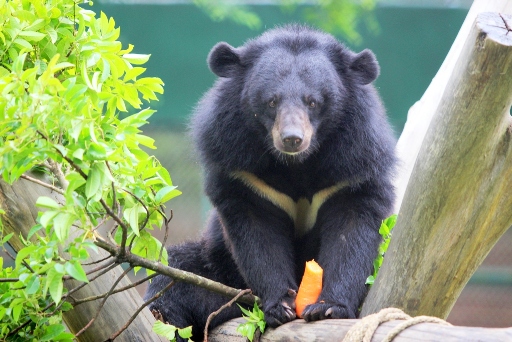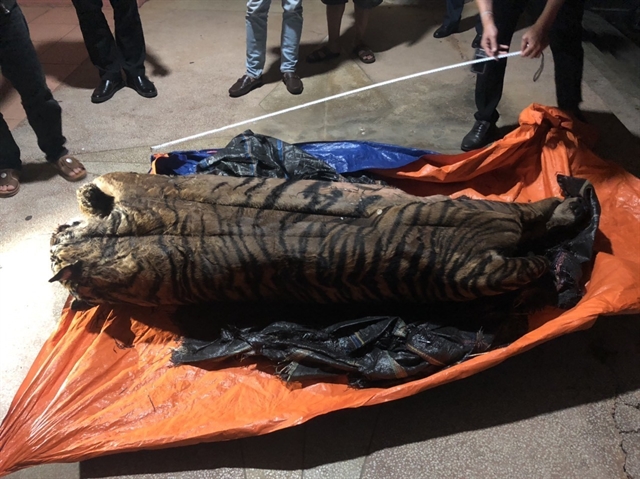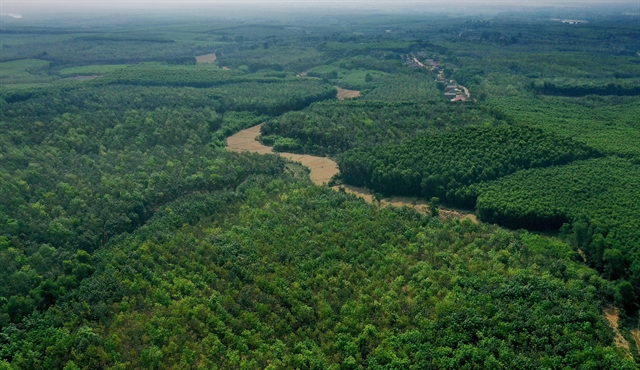 Environment
Environment

 |
| A bear at the Bear Rescue Centre Vietnam in Tam Đảo National Park in Vĩnh Phúc Province. Photo baotintuc.vn |
According to experts and officials, Việt Nam must do more to prevent wildlife trafficking, a major threat to the decline of biodiversity.
Despite progress made in banning bear bile farms, the protection of this animal should be further accelerated.
The government initiated a programme aimed at phasing out bear bile farming in the country in 2000s. In 2005, more than 4,300 captive bears were registered and microchipped as part of an effort to prevent new bears from entering farms. Nearly 20 years after the programme was launched, nearly 300 bile bears remain on farms across the country, and 40 provinces have become bear farm-free as of last year.
In 2022, Bình Phước, Thái Bình and Hà Nam became bear farm-free. HCM City, which used to be one of the country’s bear farm hot spots, had only 13 bears at private establishments.
Meanwhile, as of October 2022, the capital Hà Nội still led the country in the number of farmed bears, with a total of 140 individuals, accounting for 54.5 per cent of total farmed bears in the whole country. Hà Nội is forecast to become the last locality to have a bear farm in Việt Nam.
Bùi Thị Hà, deputy director of the Education for Nature-Vietnam (ENV) suggested that Hà Nội’s authorities have more drastic measures to end farm bears in the city by 2025.
Tiger protection
Tigers have been considered an endangered, precious and rare wild animal protected at the highest level in accordance with Vietnamese and international laws.
The law has provided for strong sanctions to handle all violations related to tigers with a penalty of up to 15 years in prison for offenders. However, the illegal trade in tigers is still a serious problem due to the demand for and use of products from this species.
In 2022 alone, the ENV recorded 399 cases of tiger-related violations, with more than 88 per cent of cases detected in cyberspace (353/399). According to the organisation, in addition to strictly handling violators, the authorities need to strengthen communication work, raise people's awareness, and advise people not to trade or use tiger products to help protect tigers and avoid legal consequences.
 |
| A tiger weighing more than 200 kg was seized by Lai Châu police in 2022 as three people tried to transport it. VNA/VNS Photo |
Legal frameworks
According to Đỗ Quang Tùng, director of the Endangered Wildlife Conservation Project under the Ministry of Agriculture and Rural Development, the legal framework for management and control of wildlife animal exploitation, breeding, processing and trading activities is complete, comprehensive and in line with practical requirements.
The Law on Forestry in 2017 and related legal documents clearly stipulate prohibited acts (including hunting, catching, raising, confining, killing, storing, transporting, trading of wildlife animals, and collecting wildlife specimens of forest plant and animal species contrary to the provisions of the law). The sanctions for violations are also strict enough to deter violations.
The 2015 Criminal Code, with amendments made in 2017, is considered the most progressive law dealing with wildlife crimes. The law alleviates sanctions and removes the death sentence on some kinds of crimes, but imposes heavier penalties on wildlife criminals.
The dissemination of the law, the inter-sectoral coordination of ministries, branches and localities in law enforcement, inspection, control, prevention and handling of violations have been carried out synchronously and regularly, he added.
Many violations are detected and strictly handled in accordance with the law. Along with that, people's awareness has been enhanced and changed, Tùng said, adding that the demand for using wild animals and wildlife products for food, pharmaceuticals and jewellery has declined.
According to the ENV, in 2022, authorities have seized or received and transferred a total of live 2,101 wildlife animals including 97 monkeys, 22 bears (Asiatic black bear), 12 tigers and 295 tortoises and turtles.
An annual report by the organisation showed that last year 1,247 online wildlife ads were successfully removed thanks to the intervention of the authorities, the law enforcement recommendation of the ENV and the coordination of social network providers.
Since early 2022, a total of 92 pages and groups for wildlife trading with 243,336 members have been deactivated.
Biodiversity that needs to be preserved
Việt Nam is ranked 16th among the Earth's most biodiverse countries and is one of the ten richest centres of biodiversity in the world with many different types of ecosystems and genetic sources.
With a wide range of latitudes, Việt Nam's climate varies from humid tropical conditions in the southern lowlands to temperate conditions in the northern highlands. Consequently, the country enjoys a diversity of natural environments and a high level of biodiversity in its forests, waterways, and marine areas, according to a report by the World Wide Fund For Nature (WWF).
 |
| Forest in the central province of Quảng Trị. Protecting forests is key to biodiversity as they cover almost a third of the global land area and harbour most of the Earth's terrestrial biodiversity. VNA/VNS Photo Hồ Cầu |
It is home to an estimated 12,000 species of plants. About 33 per cent of the flora of northern Việt Nam are endemic and, nationally, the percentage of endemism could be as high as 50 per cent.
The country also has a wealth of fauna varieties: 276 species of mammals, 828 species of birds, 180 species of reptiles, 80 species of amphibians, 472 species of freshwater fish, and many thousands of invertebrate species have been identified.
These groups show a high degree of local distinctiveness, with many endemic species of great scientific and economic significance. Of the 34 globally threatened birds identified as occurring in Việt Nam, 10 are restricted-range endemic forest species. Sixty fish species and four primate species are also endemic to Việt Nam.
However, the diversity in Việt Nam is in danger because of unsustainable and poorly managed exploitation, an increase in population and rapid urbanisation, according to the Ministry of Natural Resources and Environment.
The reasons that lead to biodiversity decline are rapid population growth, pollution, deforestation, the over-exploitation of marine resources and widely applied new species without careful examination. That has led to 28 per cent of mammals, 10 per cent of birds, 21 per cent of reptiles and amphibians facing risk of extinction.
The increase of wild animals trafficking and consumption has driven many rare species in the edge of extinction. The illegal consumption of wildlife not only massacres wild animal populations but also destroys ecosystems. VNS




